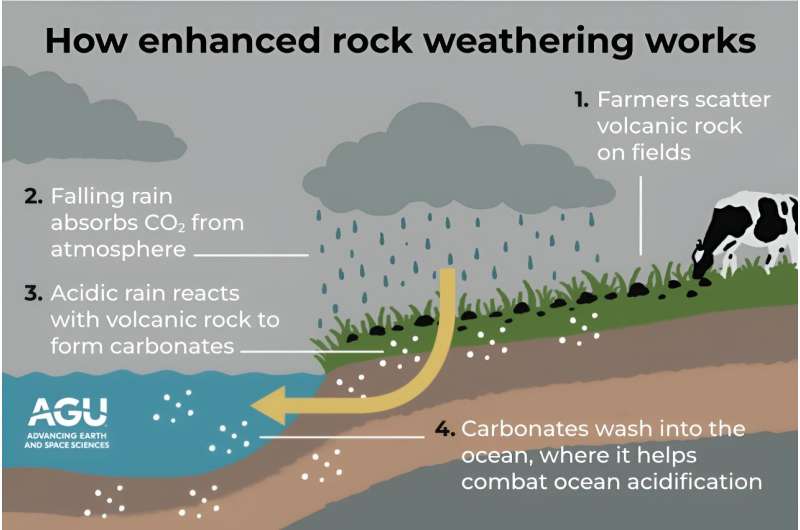
A new study reports that farmers worldwide can contribute to achieving a crucial carbon removal goal set by the Intergovernmental Panel on Climate Change (IPCC) by incorporating crushed volcanic rocks into their fields. This study emphasizes the wet, warm tropics as the most promising regions for this climate intervention strategy.
In a significant development, the study provides one of the first estimates of the potential carbon dioxide drawdown resulting from the application of basalt in agricultural fields worldwide. Published in Earth’s Future, the study explores the concept of enhanced rock weathering, which harnesses the natural weathering process to sequester carbon dioxide in carbonate minerals. By accelerating weathering in a way that offers additional benefits to humans, such as soil improvement and countering ocean acidification, this approach can effectively complement emissions reduction efforts and mitigate climate change.
Furthermore, the researchers assert that enhanced rock weathering poses fewer risks compared to other climate interventions, making it a more socially desirable option. According to S. Hun Baek, a climate scientist at Yale University who led the study, this strategy not only helps address climate change but also rejuvenates depleted soils and combats ocean acidification.
The study conducted by Yale University investigates the potential of utilizing crushed basalt, an easily weathered rock formed from cooled lava, in agricultural fields across the globe. It identifies the regions that can efficiently facilitate the breakdown of these rocks. Noah Planavsky, a co-author of the study and geochemist at Yale University, expresses enthusiasm for the potential of enhanced rock weathering but emphasizes the need to focus on market and finance perspectives to ensure viable implementation.
Prior studies estimated carbon drawdown using different methods, but this research aims to expand the analysis beyond national boundaries and into the future. By employing a novel biogeochemical model, the researchers simulated the effects of enhanced rock weathering on 1,000 agricultural sites worldwide under two emissions scenarios from 2006 to 2080. The results indicate that these sites would collectively draw down 64 gigatons of carbon dioxide over a 75-year period. Extrapolating this finding to all agricultural fields suggests that up to 217 gigatons of carbon could be sequestered through the widespread application of this strategy.
The study aligns with the IPCC’s call to remove 100 to 1,000 gigatons of carbon by 2100 to limit global temperature rise to less than one and a half degrees Celsius. Baek emphasizes that the estimated carbon removal achieved through enhanced rock weathering falls within this target range.
The research highlights the significance of implementing this climate intervention in tropical regions due to the accelerated weathering process in hot and wet environments. Moreover, the study suggests that enhanced rock weathering proves resilient to climate change and performs equally well or even better under warmer temperatures compared to other carbon drawdown approaches.
Considering that farmers already use limestone on their fields for nutrient delivery and soil acidity control, transitioning to enhanced rock weathering, which involves gradually changing the rock type, could be a seamless process. Planavsky underscores the need to progress from small-scale applications to realistic implementation.
More information:
Seung H. Baek et al, Impact of Climate on the Global Capacity for Enhanced Rock Weathering on Croplands, Earth’s Future (2023). DOI: 10.1029/2023EF003698
Citation:
‘Planting’ rocks in farms, along with emissions reductions, could help meet key IPCC carbon removal goal (2023, August 14)
retrieved 14 August 2023
from https://phys.org/news/2023-08-farms-emissions-reductions-key-ipcc.html
This document is subject to copyright. Apart from any fair dealing for the purpose of private study or research, no
part may be reproduced without the written permission. The content is provided for information purposes only.
Denial of responsibility! TechCodex is an automatic aggregator of the all world’s media. In each content, the hyperlink to the primary source is specified. All trademarks belong to their rightful owners, and all materials to their authors. For any complaint, please reach us at – [email protected]. We will take necessary action within 24 hours.

Jessica Irvine is a tech enthusiast specializing in gadgets. From smart home devices to cutting-edge electronics, Jessica explores the world of consumer tech, offering readers comprehensive reviews, hands-on experiences, and expert insights into the coolest and most innovative gadgets on the market.


